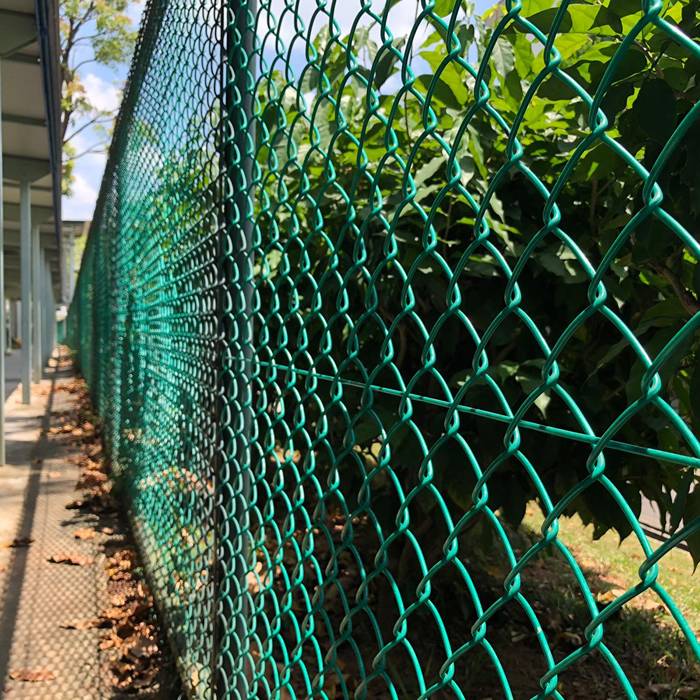Don't miss our holiday offer - 20% OFF!
Maintenance of Diamond Mesh Fencing to Ensure Durability

The exterior of your home is like a canvas waiting to be painted. It truly reflects your personal style and ensures your safety and privacy. To complete this canvas, adding a diamond mesh fence to protect your backyard, surround your pool, or simply mark the perimeter of your property could be a wise choice.
If you’ve chosen a diamond mesh fence as a protective boundary, this blog post may be helpful. It provides a comprehensive guide on how to maintain this type of fence. Specifically, it will focus on inspecting, cleaning, and repairing your diamond mesh fence to ensure it maintains structural integrity.
What is a Diamond Mesh Fence?
A diamond mesh fence is commonly referred to as a chain-link fence or wire mesh fence. You might also have heard the term “diamond steel fence.” However, this term isn’t widely recognized in the fencing industry. It seems to describe this type of steel fence in a non-standard way. So, for the purposes of this discussion, when we mention a diamond mesh fence, we are referring to chain-link or wire mesh fences.
So, what exactly is a diamond mesh fence? It’s a type of fence characterized by its unique diamond pattern, formed by interlinked steel wires.
Why is Fence Maintenance Important?
There are several reasons why fence maintenance is crucial. Here are a few:
- Maintain the appearance of your diamond mesh fence.
- Enhance the durability of the steel fence.
- Protect against elements like rain, wind, and UV rays.
- Increase security and privacy for your property.
- Boost your property’s value.
- Ensure compliance with legal regulations.
- Proper maintenance is cost-effective (as opposed to replacing sections or the entire fence).
- Give you peace of mind, knowing your fence remains attractive and functional.
Inspecting Your Diamond Mesh Fence
Regular inspections of your diamond mesh fence help you detect any issues early. This way, you can address them before they become more serious.
Here are some ways to inspect your chain-link fence:
- Walk along the fence and visually inspect each section thoroughly.
- Check the posts. If you notice any signs of leaning, warping, or damage, it’s time to replace them as they could compromise the fence’s structural integrity.
- Examine the top and bottom rails to ensure they are securely attached to the posts. Also, check for any other damage, including rust.
- Inspect the mesh for any loose, damaged, or corroded sections, and replace them as soon as possible.
- Rust and corrosion are common issues with steel diamond mesh fences. Pay special attention to joints and areas where protective coatings may be worn or damaged.
- Gates, if any, should be able to swing freely. All latches and hinges should be in good working order and lubricated as necessary.
- Vegetation should be controlled, as overgrown plants and vines can accelerate corrosion.
- Test the tension of the fence. Loose or sagging sections may need adjustments to maintain the structural strength of the mesh.
Cleaning the Fence
Cleaning your diamond mesh fence is an essential part of regular maintenance to keep it looking good and prolong its lifespan.
How to effectively clean a diamond mesh fence:
- The right tools and materials are essential.
- A garden hose or pressure washer.
- Mild cleaning detergent (a mixture of gentle dish soap or specialized fence cleaner with water).
- A nylon brush or cloth.
- Safety gear: For safety reasons, wear gloves and safety goggles.
Cleaning the fence:
- Clear debris.
- Prepare a cleaning solution (mild detergent).
- Apply the solution.
- Rinse thoroughly.
- Check for stubborn stains, and scrub the area carefully if necessary.
- Dry the fence (air dry or use a clean dry cloth).
Handling Rust and Corrosion
When dealing with rust and corrosion, as with cleaning, having the right tools and materials is crucial.
You’ll need:
- A wire brush to remove loose rust.
- Sandpaper (medium grit) to smooth the surface after rust removal.
- Rust converter to transform rust into a more stable form.
- Primer to prepare the surface for painting. It also helps prevent future corrosion.
- Paint that is suitable for outdoor use.
- Brush or spray gun, depending on your preference.
Steps:
- First, take safety precautions. Wear appropriate safety gear.
- Prepare the surface. Use the wire brush to clean the rusty areas of the fence, and then sand the surface for better adhesion.
- Apply rust converter.
- Prime the surface.
- Paint the fence: Use a spray gun or brush.
Repairing Damaged Sections
Repairing damaged parts of a diamond mesh fence also requires the right tools and materials:
- Safety gear.
- Replacement parts.
- Wire cutters or pliers.
- Wrench or socket set.
- Tension bands.
- Tension bar.
- Fasteners (nuts, bolts, and screws).
Steps:
- Assess the damage.
- Use the proper tools to disconnect the damaged section from the rest of the fence.
- Carefully remove the damaged parts.
- Prepare to install the necessary replacement parts.
- Attach new components.
- Adjust the tension of the diamond mesh fence.
- Reconnect the repaired section to the fence.
- Secure the fasteners.
- Paint the fence if needed.
Interested in Diamond Mesh Fencing? Inquire About It!
If you’re interested in learning about the steel fencing options Diamond Fence offers in Melbourne and the Greater Victoria area, we encourage you to get in touch with us today!
You can reach us by emailing [email protected] or calling our hotline at +86 18631807666.
For your convenience, we also offer an online consultation form, providing you with an efficient way to communicate with us. This form allows you to submit any inquiries or concerns.
We eagerly look forward to the opportunity to assist you further and provide the necessary details regarding your steel fencing queries.
